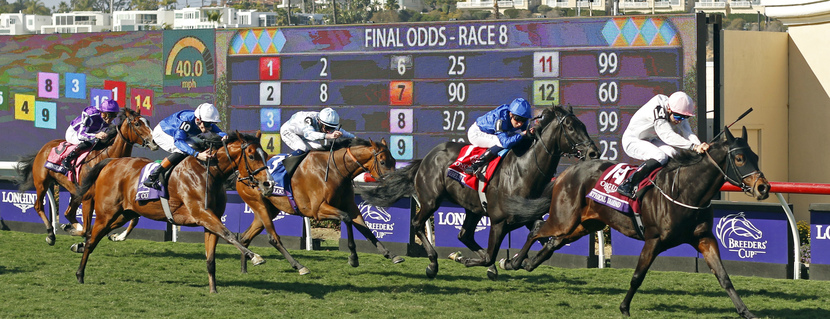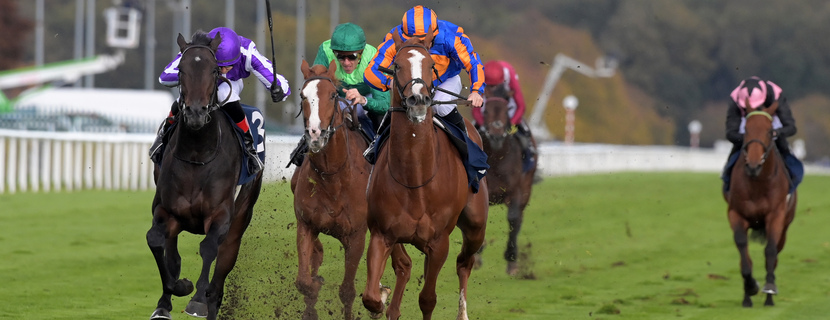This article is slightly different from my usual pieces in that I am going to address some of the questions you have asked in the comments over the past couple of years, writes Dave Renham.
As the turf flat season has come to an end, I will concentrate on some of the National Hunt questions that have been posed. Any profit and loss figures quoted have been calculated to Betfair Starting Price less 5% commission. Data have been taken from UK NH racing going back to 1st Jan 2017. Here we go...
Does the market position of the horse on debut make any difference in their next few runs?
For this answer I am going to combine the stats for all horses having their second, third, fourth and fifth careers starts. Horses that were favourite on their debut have gone on to win just under 20% of the time when grouping together all the results of their next four races. The graph below shows the second to fifth run combined strike rate for different market positions on debut:

The graph shows that the position a horse appears in the betting market on debut has an influence on their success early in their careers. In terms of returns, favourites on debut have got close to breaking even if you had backed them in all of their next four starts. Compare this to horses that that were 5th or higher in the betting market on debut – they would have combined to lose you over 20 pence in the £.
How successful are beaten favourites on their next start?
Horses that were beaten favourites last time out scored in 18.6% of their next starts; but backing all qualifiers would have produced a loss of 6p for every £1 staked. Looking at horses that were beaten favourite two starts back, they have produced a strike rate of 17.3% with slightly higher losses of 7p in the £.
Horses that have been beaten favourites on both of their last two starts have won just under 20% of the time, but losses have been steeper at 9p in the £. These are generally worth swerving!
Is wearing blinkers for the first time a positive or a negative?
Trainers turn to headgear in an attempt to make it easier for the horse to focus on what is in front of them rather than being distracted by other horses or the crowd etc in their peripheral vision. Hence, trainers hope that the application of blinkers will help the horse concentrate better and thus perform better. However, the stats point to the fact that horses in first time blinkers are a negative.
First time blinker wearers have won 8.5% of their races (205 wins from 2402 runs) producing losses of £367.95 (ROI -15.3%). One positive stat worth sharing is that if the horse was prominent in the betting (SP of 9/4 or less), this subset of first time wearers made a profit, albeit from a small sample. There were 104 qualifying horses of which 49 won (SR 47.1%) for a profit of £28.75 (ROI +27.6%).
Trainer Gary Moore has a good record with horses wearing blinkers for the first time scoring 7 times from 28 Runners (SR 25%) for a profit of £30.27 (ROI +108.1%). Yes, it is a very small sample but there are two other positives I can share. Firstly, seven other runners were placed, giving Moore a win and placed strike rate of 50%; and secondly, I checked his 2013 to 2016 results also and he won 5 from 18 (SR 27.8%) for a profit of £30.42 (ROI +169.03).
Of course, there are other headgear options and the application of first time cheekpieces has produced much better overall results than first time blinkers. The stats show that 10.7% of these runners won and losses stood at only 1.2% - or just over 1 p in the £ lost for every £1 staked.
How does the weight a horse carries in a handicap chase affect the result?
Horses are assigned different handicap marks in handicap races which affects how much weight a horse will carry. Better horses with higher handicap marks (Official Ratings) carry more weight. The idea is that the weight will balance out the differences in ability with the theory that any handicap race will end with all runners finishing at the same time. The handicapper does an excellent job, but higher weighted horses still win more often than lower weighted runners. The graph below shows this:
Top weights in handicap chases are more than twice as likely to win as horses weighted 7th or lower. However, the market does adjust for this. Top weights, despite their decent win rate, would have lost you around 7 pence in the £ if backing all of them ‘blind’. Horses that were 7th or lower in the weights actually turned a small BSP profit. Of course, a few big-priced winners did skew these results somewhat, but even without those you could legitimately argue that lower weighted horses offer slightly better value in these races.
What percentage of races are won by a horse from the top three in the betting?
When combining the results of all National Hunt races, the winner comes from the top three in the betting in 73% of races. However, there is a big variance depending on type of race. Here is a table showing the performance of the top three in the betting in different race types. I have ordered the table row from highest percentage to lowest:
Handicap races are generally more competitive than non-handicaps which is one of the reasons why the lowest figures are for the handicap groups. Having said that, field size plays a part and handicaps tend to have bigger fields which naturally impacts the percentages. In terms of returns, horses from the top three in the betting have performed best in non-handicap novice chases – these runners would have lost you just 1p for every £10 bet (ROI -0.1%).
Have you any breeding stats that will help with my National Hunt betting?
Here are my favourite stats connected with breeding.
- When looking at French-bred runners, did you know that female horses have outperformed male horses in terms of strike rate? This is unusual as male horses have a general strike rate edge over female runners in all types of racing be it flat, all weather or National Hunt. French-bred runners that are female have won 13.72% of their races; males have won 13.57%. Females have provided by far the best value of the two also – males would have lost you 9p in the £; females would have won you 14p in the £. I should also say that French-bred females have a strike rate edge in both hurdle races and chases. Male French-bred runners enjoy a small edge in bumpers.
- There are a handful of sires whose chase record is considerably better than their hurdles one. Muhtathir is one such sire. His chase SR% stands at 18% while his hurdle one is just 7.9%. In terms of A/E indices, his chase index is 1.04, his hurdle one is just 0.61. Another sire with a similar bias is Schiaparelli. His hurdle SR% has been 9.3% (A/E 0.79); his chase SR% more than double that at 18.9% (A/E 1.02). Fuisse has similar stats to Schiaparelli – he has a 21.4% strike rate in chases (A/E 1.14), in hurdles this drops to 11.9% (A/E 0.81). Both Fuisse and Schiaparelli have made blind profits in chases to BSP.
- Sire Trans Island performs much better in hurdle races compared to chases. Strike rates are 13% (hurdle races) versus 8% (chases) with the A/E indices standing at 1.10 and 0.70 respectively. Coastal Path is another sire who seems to have a clear edge when comparing hurdle results to chase ones. In chases he has a 12.1% SR% with his runners showing hefty losses of 44p in the £; in hurdle races the strike rate is 17.7% and his runners have made a blind profit of £322.48 (ROI +107.9%).
- Poliglote is a sire that only has a handful of hurdlers these days, but he is the only sire to secure a strike rate of over 20% in these races over the lesser obstacles (44 wins from 215 runners). Returns of 73 pence in the £ is noteworthy and hence any hurdler sired by Poliglote is worth close scrutiny.
Are there any trainers who do particularly well in bumpers?
Let’s start by looking at the trainers with the highest strike rates in bumpers. In order for them to qualify they must have had at least 75 runners and achieved a 20% win rate or higher:
It will probably come as no surprise to see Paul Nicholls and Nicky Henderson at the top. However, neither have made an overall profit, losing 4p and 5p in the £ respectively. There is a profitable angle for both Nicholls and Henderson though when we dig a bit deeper into the numbers – and it is the same angle. For both trainers you would have made a profit if ignoring horses on debut and those with just one run under their belt. For Henderson, horses having their second or more career start have won 20 races from 79 (SR 25.3%) for a profit of £23.13 (ROI +29.3%); for Nicholls he has had 21 winners from 69 (SR 30.4%) showing a profit of £18.79 (ROI +27.2%).
There is one more trainer I would like to mention who does not appear on the above graph and that is Hughie Morrison. Morrison is probably better known as a trainer on the level, but he has an excellent record albeit from a smaller sample. He has had 58 bumper runners since 2017 of which 14 have won (SR 24.1%) recording a profit of £24.87 (ROI +42.9%). In fact, 7 of his last 19 runners (SR 36.8%) have won.
Sticking a little bit longer with bumpers, there are two trainers who have done particularly well with bumper debutants. Harry Fry and Anthony Honeyball are the trainers in question. Their figures are impressive:
Both trainers have been consistent, each making a profit in five of the seven seasons.
Which trainers do best with horses that make their career debut in a hurdle race?
Just under 70% of all National Hunt horses have their first ever run in a bumper. However, a good proportion start off their careers by ignoring the bumper route and going straight over hurdles. One trainer excels with these runners, namely Nicky Henderson. His record is outstanding:
The win strike rate is on another stratosphere with only two other trainers hitting over 20% (20% and 26% for Donald McCain and Paul Nicholls respectively). His biggest priced winner has been at 11/1 (BSP 17) so his results are not skewed in any way. Henderson also seems to target hurdle races at Newbury as 11 of his 18 runners (SR 61.1%) have won there on debut.
There are two stables to avoid, however, when they send an unraced horse over hurdles for their debut. Firstly, Venetia Williams has saddled just three winners from 52 (SR 5.8%) for a loss of £35.65 (ROI -68.6%). In fact, 31 of these runners started at single figure odds so this is not a case of lots of outsiders losing. The other stable to avoid is the Oliver Greenall and Josh Guerriero yard. They have managed just two winners from 64 runners (SR 3.1%) for a hefty loss of £52.38 (ROI -81.8%). In truth, a fair proportion of their runners have been at the higher end of the price spectrum, but regardless of price I think a wide berth is the prudent call.
At the Cheltenham Festival Irish trainers seem to excel. What is the record of Irish trainers in all UK National Hunt Races?
Here are the stats for all Irish trained runners in the UK going back to 2017:
This is an impressive set of figures. Having said that, 80% of the profits occurred at the Cheltenham Festival from around 28% of the total runners.
The Irish seem to target the better meetings and the bigger prizes. There are four courses where they have had at least 200 runners – all four have seen a blind profit as the table below shows:
It is no surprise that Cheltenham has seen the best returns, but the Perth stats are strong, too. It makes sense to me that when you see an Irish runner declared at any of these four tracks you should look carefully into their chances. If the race is a class 1 or 2 contest, then that has also been a positive.
Trainers with sole runners on the day – are any worth following?
The penultimate question for this piece concerns trainers who have had just one runner racing on a particular day. Firstly, let us see the trainers with the best strike rates with these sole runners.
The usual suspects of Nicholls and Henderson head the list, but it is interesting to see Ann Hamilton in fourth place. Six of the ten earned a blind profit – Henderson, Skelton, Hamilton, Richards, Lacey and Bailey. As far as Henderson is concerned, if you ignored his runners that started favourite, his record is mightily impressive with 53 wins from 249 runners (SR 21.3%) for a profit of £117.99 (ROI +47.4%). This subset of runners would have yielded a profit in six of the seven years.
What is the comparison of novice chase debutants with horses having their second chase start in a novice chase?
This is a very recent question which was asked after I wrote a piece on chase debutants. I was asked about trainer improvement between chase debut in a novice chase and the second chase start in a novice chase. Horses that are racing for the first or second time often contest novice chase events so there is a reasonable data set for some trainers.
Firstly, let me compare the overall strike rates in novice chases between horses having their first ever chase run compared with those contesting a novice chase having only their second run over fences:
As you can see, and might expect, horses improve for the experience. Remarkably, horses having their second chase run have made a blind profit when they raced in a novice chase on this second start. That 18% strike rate has helped turn a 7p in the £ profit.
Now to compare trainer performance. Below is a table displaying individual trainer strike rates on chase debut and 2nd chase run. Once again, these figures apply only when the race in question was a novice chase. To qualify each trainer has had at least 30 runs for each group. I have also created an extra column where I have divided the 2nd run SR% by the debut SR%. To show an improvement this figure needs to be higher than 1.00. I have ordered the table by ‘improvement’:
Tim Vaughan has shown a remarkable improvement going from 4 wins from 72 on debut to 9 wins from 33 on second start. There is also a significant differential when comparing the Evan Williams stats. There are very few trainers whose chase debutants out-perform their second chase starters but there are a handful (at the bottom of the table). I hope this table will prove useful to assess how likely a horse is to improve from chase debut to second chase run.
As stated, this final question has been geared to novice chase data only. Not all first- and second-time chasers race in a novice chase. Hence you would get bigger data sets if you allowed ‘all chases’ to be analysed for these two groups of runners. Having said that, I have looked briefly at that data, too, and the results for most of the above trainers are similar.
So, there you have it – a selection of answers to the many questions I have been asked about National Hunt racing in recent times. If you have any specific questions, please post them in the comments. It might inspire a new article!
- DR

























Dave, that is a fantastic analysis – covering a variety of angles. Thank you.
One question about the career debut in hurdle races. Did you ignore P2P runs when looking at debutants – or were horses with P2P form excluded from your analysis?
I wonder if (after you’ve had a well earned rest) you might attempt a breakdown of NH sires – highlighting the likely going preference of their progeny – I’ve not been able to find an up to date table that lists this detail. Can you help?
thanks again for your amazing report
Alan
Hi Alan
We have a report called Sire Snippets that shows the performance of sires on today’s going. Alternatively, our Profiler tool will allow you to review the going breakdown for any sire you like, amongst many other things. You can find that here: https://www.geegeez.co.uk/tools/profiler-tool/
Best,
Matt
Thanks Alan
No P2P data is included – only racing under rules.
Regarding sires – at some point I will try and get round to a detailed sire piece. As Matt said in his reply the sire snippets and the profiler tool are great options to get that type of data, thnx Dave
Comments are closed.